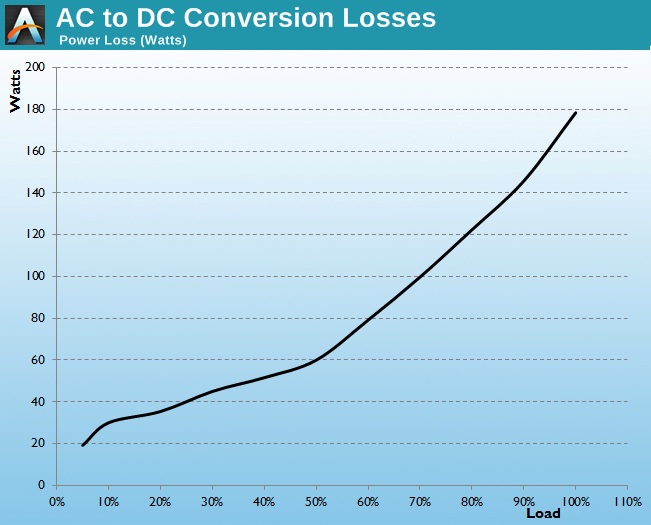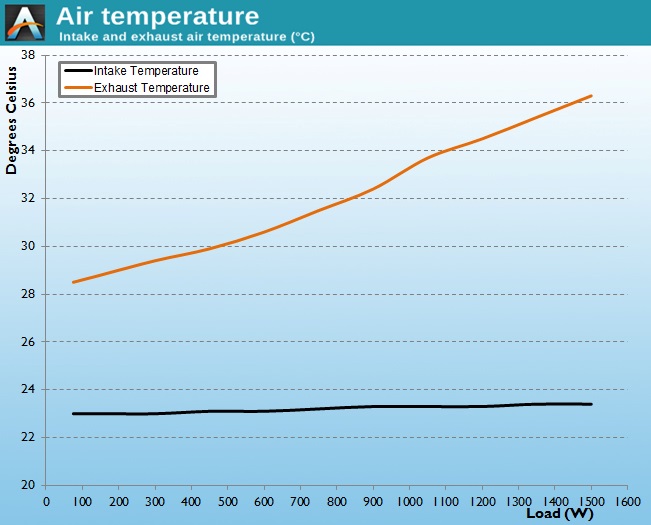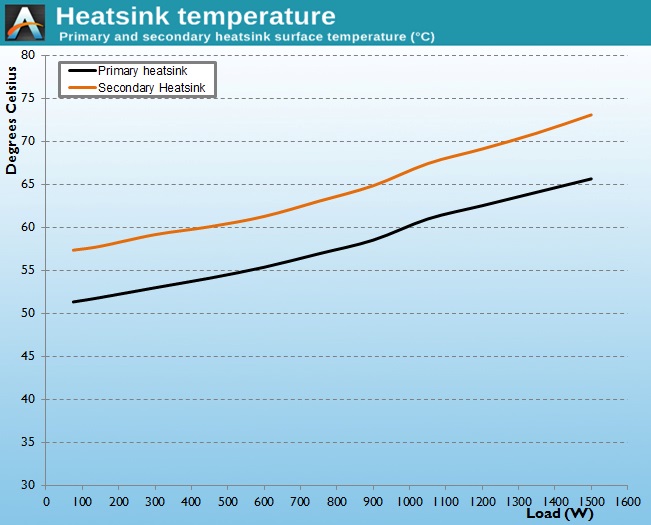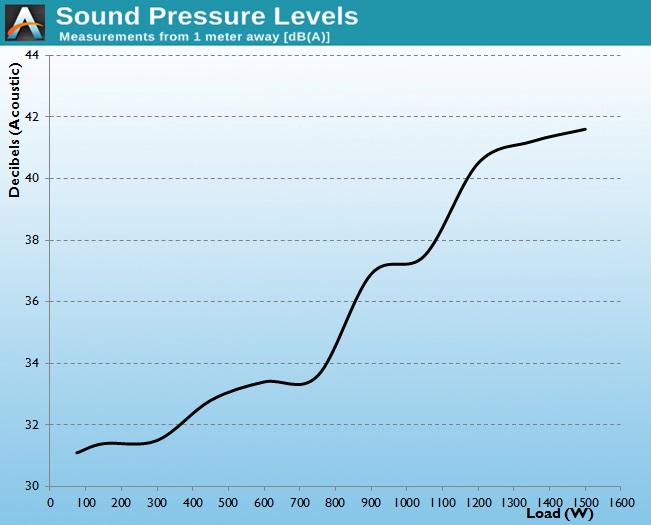The SilverStone Strider Gold S 1500W PSU Review
by E. Fylladitakis on April 7, 2015 8:00 AM EST- Posted in
- Cases/Cooling/PSUs
- PSUs
- SilverStone
- 1500W
Cold Test Results
For the testing of PSUs, we are using high precision electronic loads with a maximum power draw of 2700 Watts, a Rigol DS5042M 40 MHz oscilloscope, an Extech 380803 power analyzer, two high precision UNI-T UT-325 digital thermometers, an Extech HD600 SPL meter, a self-designed hotbox and various other bits and parts. For a thorough explanation of our testing methodology and more details on our equipment, please refer to our How We Test PSUs - 2014 Pipeline post.
The SilverStone Strider Gold S 1500W met its 80Plus Gold conversion efficiency requirements, even if only barely. We recorded a maximum conversion efficiency of 90% at 50% load and an average of 90.0% within the nominal load range (20% to 100% of the unit's capacity). Low load performance is mediocre, with the ST1500-GS maintaining an efficiency of 80% at 10% load, which drops to 74.4% at just 5% load. These are actually good figures considering the size of the power supply, yet they are nothing special by today's standards.
Always considering its massive power output, the ST1500-GS maintains very low internal temperatures. The primary heatsink of the PSU barely reached 67°C under maximum load, when the four transistors were pumping more than 1.5kW to the main transformer. This can be partially attributed to the "stepping" behavior of the cooling fan. While the load is low, the fan is barely audible when unobstructed, meaning that it would be virtually imperceptible with the PSU installed inside a case. At 55%-60% load, the speed of the fan steps up and the fan becomes audible, yet the noise output remains within comfortable limits. If the load exceeds 70% of the unit's capacity, then the fan speed steps up again, making the fan clearly audible and clearly prioritizing thermal performance over acoustics.















32 Comments
View All Comments
Gigaplex - Tuesday, April 7, 2015 - link
reininop: "the efficiency of these usually peaks at about 50 - 70% of rated power"DanNeely: "You obviously didn't read much if any of the article: You're way off..[snip].. and peaked at 92% efficient at a 50% load."
I'd say reininop was spot on. They were stating that efficiency is at its best at 50%-70% load, not that the PSU is 50%-70% efficient.
reininop - Wednesday, April 8, 2015 - link
You know, I typically read the intro and the final words and then if I find it interesting I go back and read the rest. In this case, I read some of the comments first as well. I have since went back and saw your power efficiency graph. I felt the comment was meant to be taking as a bit of a joke as I was pointing out a user case that almost certainly doesn't exist. For some reason, you seemed to take personal offense to it.As for the rest of you comment, I am well aware of what the 80+ gold means. I never said anything about the conversion efficiency, only the peak rate of efficiency as a function of the output power. Hence, when I said tech enthusiast, I was attempting to imply someone who actually has components that require 750 W to operate. I assume the confusion arose from my use of the word "pull" when discussing the actual system power requirements and you assumed I meant the outlet power.
KAlmquist - Wednesday, April 8, 2015 - link
The problem for the eco-conscious tech enthusiast is that the efficiency of this power supply drops significantly when power consumption falls below 300 watts. So it may be efficient during heavy gaming, but not so much when you take a break to post comments on anandtech.com.wbwb - Wednesday, April 8, 2015 - link
On the other hand, at idle load, an improvement in efficiency can make a difference of only a few watts, so it's understandable that the focus of 80plus has been on efficiency at higher loads where a little improvement can make a big difference. That was the low-hanging fruit. With that taken care of, they should now be improving the low end.Poik - Tuesday, April 7, 2015 - link
I'd just like to point out that anything above a 1440W PSU (assuming that's what they're pulling off the "mains") should really be on a 20A breaker/circuit. I know that 20A circuits are very common in the US - but they're far less common in Canada.The reason for this is that in both Canada and the US (and Europe too?) the normal household breakers are only rated to sustain 80% of their rated capacity. Ergo a 15A breaker will only hold 12A and a 20A breaker will hold 16A. Respectively those are good for 1440W and 1920W.
It's good to see the C19 plug being used here as that should force people to use a 20A T-slot plug (15/20A Hybrid) that should be common in the US. It seems very few people are aware of this but it's an important consideration - especially if you plan on using this PSU to its full potential.
Gigaplex - Tuesday, April 7, 2015 - link
Or, like the bulk of the rest of the world, it should run at ~240V.Pissedoffyouth - Wednesday, April 8, 2015 - link
Hmm really puts in perspective how lucky we are to have 240v in rest of worldex_User - Wednesday, April 8, 2015 - link
Consumer-grade 1500W PSU in year 2015? Buying one should be a freaking criminal offense -- together with multi-GPU setups and such. Really, people, wake the frack up!Oxford Guy - Thursday, April 9, 2015 - link
Criminal offense? How about asking people who just dropped 800 or more dollars on monitors (which you can still buy today) to replace them because the manufacturer isn't going to bother updating its firmware to support Freesync?ZeliaS - Wednesday, April 8, 2015 - link
Throwing this out there, I've owned a SilverStone Zeus 850W PSU for more than 8 years now... Switched 4 PC configurations on it. There were periods of more than 2 years without cleaning it. About an year ago I measured it extensively, I literally had to bend down in an efford to hear the fan, and all I have to say about my (first) experience with the brand is rounded up in one word - immaculate.